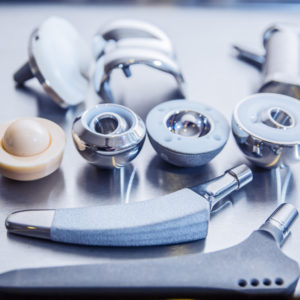Stryker Trident Hip Replacement Lawsuit Filed Over Failed Accolade Stem and LFit v40 Femoral Head

While most hip replacements are expected to last fifteen to twenty years, a product liability lawsuit filed by a California man indicates that only seven years after receiving a Stryker Trident hip replacement, revision surgery was necessary to remove a Stryker LFit v40 femoral head and Accolade TMZF femoral stem, after the components failed.
The complaint (PDF) was filed by Larry R. Schneider in the U.S. District Court for the Central District of California on July 25, indicating that the hip components were defective and unreasonably dangerous, especially when used together.
Schneider underwent a left total hip arthroplasty due to degenerative joint disease in April 2007, at which time he implanted with a Stryker Trident Hemispherical Acetabular Shell, which contained a Trident X3 Polyethylene Insert with an Accolade TMZF femoral stem and LFIT Anatomical V40 Femoral Head. However, by November 2014, the Stryker hip implant failed due to a dissociation of the femoral head from the trunnion.

Learn More About
Lawsuits are being reviewed for several different dangerous and defective hip replacement systems.
Learn More See If You Qualify For CompensationAs a result of the hip failure, Schneider underwent revision surgery to remove the cobalt chrome femoral head and the Accolade stem, during which the surgeon found that the trunnion was severely worn and the femoral head was shedding metal debris into Schneider’s body.
After receiving similar reports of problems among individuals nationwide, a Stryker LFit v40 hip recall was issued by the manufacturer last summer, impacting certain large-diameter femoral heads sold before 2011. At that time, Stryker acknowledged that a higher-then-expected number of individuals were experiencing problems with trunnion failure, metal wear, adverse tissue reactions and other complications.
“The material combination of a titanium alloy stem, with a cobalt chromium femoral head (like the LFIT V40), has been reported to cause fretting and corrosion. Scientists have reported the occurrence of significant fretting and corrosion caused by the combination of dissimilar metals and/or micro-motion at the junction between the stem trunnion and head bore dating back decades,” the lawsuit states. “Despite the known problems associated with pairing dissimilar metals and/or micro-motion at the junction between the metal stem and metal head, Defendant represented and warranted in its marketing materials that its proprietary alloys will not fret or corrode.”
The case filed by Schneider joins a growing number of other hip replacement lawsuits filed in recent months by individuals have suffered complications that resulted in revision surgery only a few years after receiving the implant. In particular, complications with the Stryker Accolade stem in combination with the LFit V40 femoral head have resulted in reports of excessive metallic debris, limited range of motion, disassociation, fractures and failed hip replacements.
Given similar questions of fact and law raised in complaints filed throughout the federal court system, the U.S. Judicial Panel on Multidistrict Litigation (JPML) established coordinated pretrial proceedings earlier this year for all lawsuits involving use of the Stryker LFit v40 head, centralizing the cases before U.S. District Judge Indira Talwani in the District of Massachusetts.






0 Comments